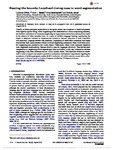Beating the bounds: Localized timing cues to word segmentation
| dc.contributor.author | White, L | |
| dc.contributor.author | Mattys, SL | |
| dc.contributor.author | Stefansdottir, L | |
| dc.contributor.author | Jones, V | |
| dc.date.accessioned | 2018-02-16T14:38:21Z | |
| dc.date.available | 2018-02-16T14:38:21Z | |
| dc.date.issued | 2015-08-01 | |
| dc.identifier.issn | 0001-4966 | |
| dc.identifier.issn | 1520-8524 | |
| dc.identifier.uri | http://hdl.handle.net/10026.1/10799 | |
| dc.description.abstract |
<jats:p>Prosody facilitates perceptual segmentation of the speech stream into a sequence of words and phrases. With regard to speech timing, vowel lengthening is well established as a cue to an upcoming boundary, but listeners' exploitation of consonant lengthening for segmentation has not been systematically tested in the absence of other boundary cues. In a series of artificial language learning experiments, the impact of durational variation in consonants and vowels on listeners' extraction of novel trisyllables was examined. Language streams with systematic lengthening of word-initial consonants were better recalled than both control streams without localized lengthening and streams where word-initial syllable lengthening was confined to the vocalic rhyme. Furthermore, where vowel-consonant sequences were lengthened word-medially, listeners failed to learn the languages effectively. Thus the structural interpretation of lengthening effects depends upon their localization, in this case, a distinction between lengthening of the onset consonant and the vocalic syllable rhyme. This functional division is considered in terms of speech-rate-sensitive predictive mechanisms and listeners' expectations regarding the occurrence of syllable perceptual centres.</jats:p> | |
| dc.format.extent | 1214-1220 | |
| dc.format.medium | ||
| dc.language | en | |
| dc.language.iso | eng | |
| dc.publisher | Acoustical Society of America (ASA) | |
| dc.subject | Adult | |
| dc.subject | Cues | |
| dc.subject | Female | |
| dc.subject | Humans | |
| dc.subject | Language | |
| dc.subject | Learning | |
| dc.subject | Male | |
| dc.subject | Phonetics | |
| dc.subject | Random Allocation | |
| dc.subject | Time Factors | |
| dc.title | Beating the bounds: Localized timing cues to word segmentation | |
| dc.type | journal-article | |
| dc.type | Article | |
| plymouth.author-url | https://www.ncbi.nlm.nih.gov/pubmed/26328734 | |
| plymouth.issue | 2 | |
| plymouth.volume | 138 | |
| plymouth.publication-status | Published | |
| plymouth.journal | The Journal of the Acoustical Society of America | |
| dc.identifier.doi | 10.1121/1.4927409 | |
| plymouth.organisational-group | /Plymouth | |
| plymouth.organisational-group | /Plymouth/REF 2021 Researchers by UoA | |
| plymouth.organisational-group | /Plymouth/REF 2021 Researchers by UoA/UoA04 Psychology, Psychiatry and Neuroscience | |
| plymouth.organisational-group | /Plymouth/REF 2021 Researchers by UoA/UoA04 Psychology, Psychiatry and Neuroscience/UoA04 Psychology, Psychiatry and Neuroscience MANUAL | |
| dc.publisher.place | United States | |
| dc.identifier.eissn | 1520-8524 | |
| dc.rights.embargoperiod | Not known | |
| rioxxterms.versionofrecord | 10.1121/1.4927409 | |
| rioxxterms.licenseref.uri | http://www.rioxx.net/licenses/all-rights-reserved | |
| rioxxterms.type | Journal Article/Review |


